The Isle of Purbeck in south east Dorset is an area of outstanding natural beauty but it is also Dorset’s oil country. I wanted to see how the demands of the oil industry could be reconciled with the demands of nature, so a few weeks ago I drove through the Purbeck Hills to Kimmeridge Bay.
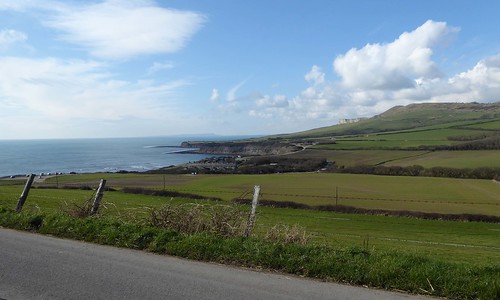
The final stage of my journey took me over the coastal limestone ridge into open countryside where the views became wider, the colours and contrasts more intense. The wide sweep of Kimmeridge Bay lay below me in the sunshine: greens and blues, shadow and light, like an image from a travel magazine. From here the road descended, tentatively, through several broad arcs to reach the thatched, stone-cottaged village and the narrow beach access road. I left the car at the cliff-top car park and got out to look. The wide semi-circular bay, backed by moderate cliffs, spread either side of me and narrow, dark-stone ledges extended from the beach like giant fingers. A few white wavelets interrupted the surface of a deep blue sea and across the water, the vast mass of Portland loomed out of the mist.
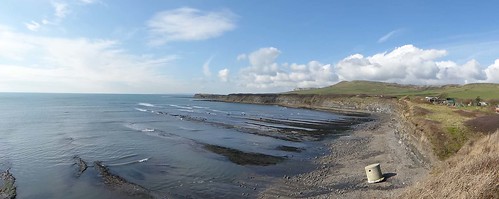
I walked away from the cliffs and followed the access road westward around the row of 19th century, grey-stone cottages. The landward side of the road was lined by sodden arable fields enlivened only by a group of pied wagtails, jittering, fluttering. Soon I reached a large wire-mesh enclosure set back from the cliff edge. Inside the enclosure were pipe work, storage tanks and a “nodding donkey” oil pump, its huge black beam moving ponderously up and down as it sucked crude oil out of the reserves buried deep below the cliff.
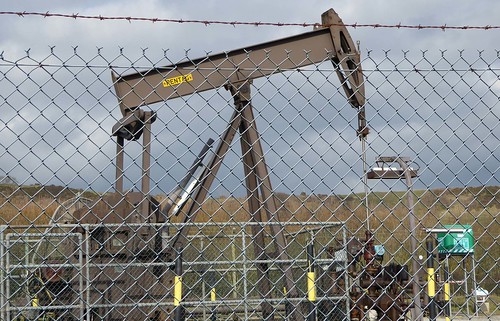
The pump has been working here since 1961 and is the oldest continuously working oil pump on the UK mainland. The oil-bearing rocks are located about 350 metres below the cliff, yielding 65 barrels of oil a day together with some natural gas. This is a modest deposit but it led to the discovery of the much larger Wytch Farm oilfield located ten or so miles away, stretching long distances under Poole Bay.
The oil pump itself is virtually noise-free as it is powered by electricity and, when I visited, there was nobody working nearby. The enclosure is some distance away from the centre of the Bay and partially screened by bushes so it is invisible to many visitors. Nevertheless, I find it incongruous to come across an oil well in this isolated, somewhat desolate and very natural place. To give myself some perspective I went to see more of the bay.
…………………………..
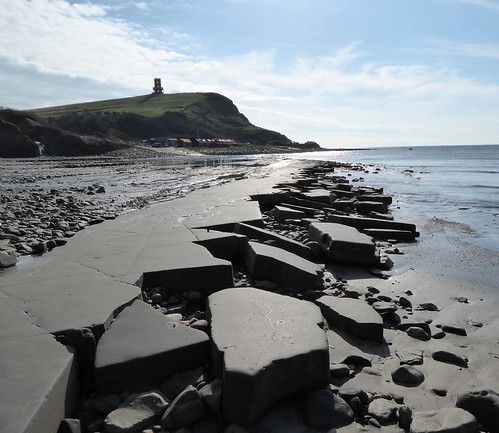
The beach is accessible down a precarious wooden stairway through a break in the cliffs, the Gaulter Gap, a narrow valley containing a fast-flowing stream. It’s a stony beach with pebbles, rocks and sand of many shades of grey, giving way to the dark stone ledges. These are visible at low tide reaching outwards into the sea and tilting slightly upwards to the west. The ledges provide great opportunities for rock-pooling and Ralph Wightman also speaks of a game of pebble bowls played along them.
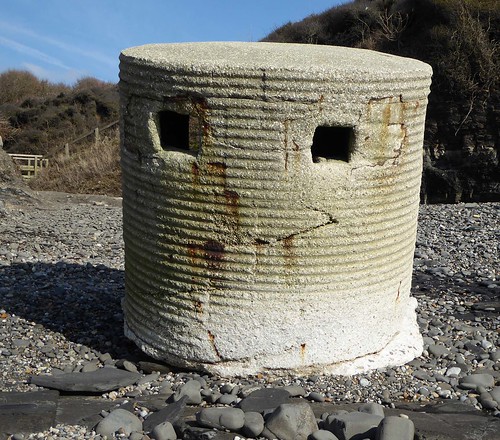
Near the Gaulter Gap the natural feel of the beach is rudely interrupted by a white cylindrical WW2 military pillbox standing on the beach looking as though someone planned to take it away but forgot. It used to sit on the cliff and its current position gives us an idea of how much erosion has occurred in the passing of 70 years.
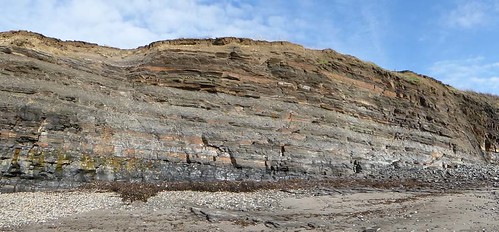
The beach is backed by grass-topped cliffs about 10 metres high containing distinct layers of rocks of different colours and textures. Bands of pale reddish brown and grey rock appear repeatedly in a semi-rhythmic pattern; differences in the hardness of the rocks and their resistance to erosion give the cliffs texture and a fascinating mosaic of colours. The rock layering in the cliffs make this both a geologist’s paradise and a geological time machine as each of the layers represents a discrete event in the Jurassic period, 200-150 million years ago.
Within the grey layers of rock is an oil shale for which Kimmeridge has been justifiably famous in the past. The richest deposits of oil shale, the “Blackstone”, are found in cliffs east of the bay. The Blackstone contains flammable hydrocarbons and used to be called “Kimmeridge Coal”. For many years it was used as a fuel, initially for cooking and heating and later for various industrial enterprises despite its high sulphur content and foul smell when burnt. In the 19th century it was mined here on an industrial scale and processed to make a range of petroleum products in Wareham and Weymouth in a series of short-lived enterprises.
The oil shale contains flammable hydrocarbons but it does not contain crude oil. Crude oil forms when the remnants of microscopic animals and plants accumulate at the bottom of the sea and are subjected to conditions of high temperature and pressure. Organic molecules are gradually converted to crude oil and this is what happened, many millions of years ago, in the rocks deep below the oil pump. The oil shale deposits exposed in the cliffs began in the same way but were never subjected to high enough temperatures or pressures to produce mature crude oil.
……………………………….
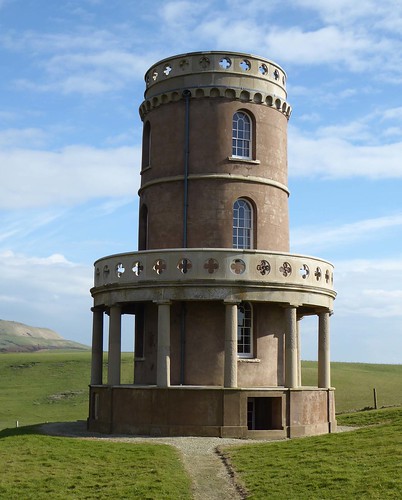
It’s a pleasant walk along the beach and out along the ledges towards the eastern end of the bay with its slipway, its jumble of boats and the cluster of black-painted, former fishermen’s huts. Behind the huts and partially hidden in the bushes is a scrub-lined, stone stairway heading steeply upwards to the top of Hen Cliff, standing 100m over the bay. This is a hard climb but worth it for the coastal views and for getting close to the Clavell Tower, a 19th century folly and observatory. This three story tower with its Tuscan colonnade stands on Hen Cliff with long views over the bay and the coast. Decked out in pink render and pale stone, it certainly looks very smart. But so it should, as starting in 2006 it was taken apart piece by piece and reassembled 25 metres away from the original site to prevent it falling in to the sea as the cliff eroded. It opened again in 2008 as an upmarket holiday rental. The Tower is now an integral part of Kimmeridge Bay but, in the past, reactions were divided. Frederick Treves, for example, referred to a “ridiculous tower” but to the Dorset dialect poet, William Barnes, in his poem “The Leady’s Tower”, it was “stately”.
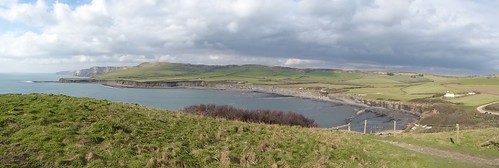
As I stood on the high cliff by the Clavell Tower, the full sweep of Kimmeridge Bay and its various landmarks were spread out below me. I had expected to be offended by the oil pump, fearing it might intrude on the natural world. But I was wrong: the oil pump is just one of several traces left by human hand at Kimmeridge Bay; it has little or no direct impact on the bay or its natural setting and is now part of the scenery. If you are looking to be offended by intrusions of the human on the natural, you could focus on the slew of wind-blown litter along the sides of the Gaulter Gap valley or the derelict, red fire engine gradually decaying behind the stone cottages.
…………………………………….
A more fundamental question does, however, arise about whether we should continue to extract this oil. Towards the end of last year the Paris Agreement recognised the need to reduce greenhouse gas emissions in order to limit the increase in global average temperature above pre-industrial levels to 2 degrees or less. Although the Agreement can be criticised for its lack of enforceability, it clearly defines the climate change problem as one of greenhouse gas emissions. A major contributor to these emissions is the burning of fossil fuels such as the oil extracted underneath Kimmeridge Bay.
Early in the 20th century, the novelist EM Forster stood a few miles north east of Kimmeridge and wrote in Howards End: “If one wanted to show a foreigner England, perhaps the wisest course would be to take him to the final section of the Purbeck Hills, and stand him on their summit….”. From this vantage point, Forster saw the rivers and landscapes of Dorset and neighbouring counties as a microcosm of all that existed in England. It wasn’t all beauty as he also saw creeping suburbia and its ill effects. Today we might relocate Forster’s vantage point and stand him by the Clavell Tower to look down on an eroding coastline under attack from increased storm activity and rising sea levels. He would also look down on the oil pump working away to extract more fossil fuels. Perhaps this alternative Purbeck view would illustrate some of the tensions inherent in contemporary England.
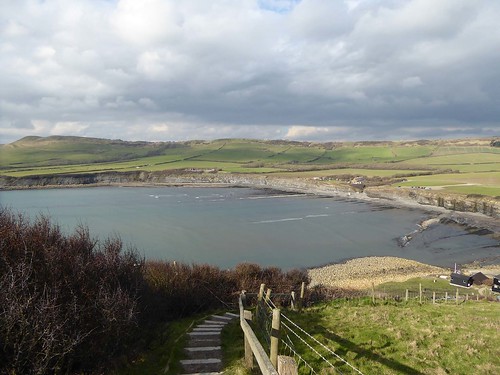
The photographs were taken on February 24th 2016


Did you pop into the Purbeck Marine Wildlife Centre or chat to any of the Dorset Wildlife Trust staff or volunteers? There’s a passionate group of people keeping an eye on Kimmeridge, and it’s one of the jewels of Dorset (in my opinion). Funnily the whole reason I’m in Dorset is due to Wytch Farm – as my father project managed a gas pipeline from there in the late 1970’s. Although we lived in Salisbury I spent a lot of time as a kid looking at nodding donkeys 🙂
LikeLike
The Marine Centre was closed when I visited (a winter midweek) which was a pity. I agree with you about Kimmeridge being a special place.
How interesting about your father and his links with Wytch Farm. I presume you have been to Furzey Island, I read that it has fascinating wildlife. I am doing a more focused article about Dorset Oil and Wytch Farm for the Marshwood Vale Magazine.
LikeLiked by 1 person
I enjoyed reading your thought provoking and balanced view of what you saw on your walk. What I don’t understand is why governments (especially those in Mediterranean countries) don’t insist on any new or extension both of domestic and industrial building having renewable energy (solar panels etc) included in their design. So much of the sun’s power is lost and it seems to me that the technology is now improving to a point where it could make a real difference. Thank you also for sharing the lovely images of your part of the country.
LikeLike
Thanks Christina. It’s a tragic missed opportunity that we dont install more renewables; the UK government seems to be discouraging renewables rather than encouraging them. History will judge us badly.
LikeLiked by 1 person
Really good piece and comments. I’ve wondered for years why installation of solar panels hasn’t been made mandatory. If nationwide all new houses, out of town shopping centres, industrial units and warehousing had solar panels (and the associated tarmac carparks were fitted with ground source heat pumps) the generation capacity would be vast. I think, and I hope, that we’re heading there, but we now need to get on the case sooner rather than later. There are real solutions out there, it simply requires political decision makers to think long term. And I really hope that Paris has generated some impetus.
If not…
LikeLiked by 1 person
Thanks for your comment Finn. I agree completely with what you say about solar panels etc, I just wish we would get on and do it.
LikeLike
So interesting, I used to live on Portland and I have no knowledge of this area now. Shows me what I missed! Amelia
LikeLike
Thanks Amelia. The Purbeck Hills and the coast are very beautiful with very striking rock formations like Old Harry, Durdle Door and Lulworth.
LikeLiked by 1 person
You did choose a wonderful day to visit Kimmeridge. The extraction of oil in Dorset has managed to blend somewhat into the landscape.It is such a contrast to the horrendous destruction being caused in Canada’s tar sands. We do need to turn towards more renewable sources to supply our energy needs. This hasn’t been helped by the Government reducing the subsidy’s for solar power and encouraging fracking. Sarah x
LikeLike
Thanks, Sarah. Yes it was a luminous day, perfect for my visit. Dorset oil seems to have been managed quite well environmentally, especially compared with some places like Canada.
I completely agree with you about the need for renewables and the lamentable attitude of our present government.
LikeLike
An interesting read – I had no idea there was oil in the south of England. I suppose there must be a refinery nearby too?
LikeLike
Thanks Cathy. There is quite a bit of oil in the Wytch Farm oil field not far from Wareham in Dorset. There is some local infrastructure but the oil is piped to Fawley near Southampton and then on to the Hamble oil terminal (91km pipeline).
LikeLike
I really enjoyed reading this Philip. As you probably know from your time in California, many of our coastal pumping stations are disguised, but there are still some “nodding donkeys” in Long Beach and Huntington Beach (Southern California) and they’ve been there as long as I can remember–a long time. 🙂 One of the oil companies has just declared bankruptcy after a significant coastal spill last year. I share your concerns about our reliance on fossil fuels, but change seems to come very slowly despite heightened ecological concerns. I must say that I would just love to walk along Kimmeridge Bay. Those limestone shelves are fascinating and unlike anything I’ve ever seen. The World War 2 pillbox fascinates me just for what it is, but then to think it’s shifted so much distance. I could go on and on….I really enjoyed this walk along the beach! And thanks for a bit of a science lesson. I really enjoyed it!
LikeLike
Thanks Debra. Yes, I remember the nodding donkeys in Southern California, also the La Brea tarpits. Yes, I think you would enjoy the beach at Kimmeridge, there are so many varied things to see and to think about.
LikeLike
An excellent post. As you know, I am a lover of all things Dorset, but I haven’t been to Kimmeridge for decades. I must make the effort soon.
I do like your main picture of the broken shale blocks on the beach – although when I first looked I noted your post title and thought Clavell Tower was an oil installation!
Being a journalist, I don’t tend to take sides in controversy, so I’m not sure what to say about green energy. I’m not sure we are in a position yet to go totally to renewables, and I detest nuclear.
My favourite energy is the Scottish Hydro, or other sorts of water power, but I suppose we don’t have the landscape here in the south – and don’t want to ruin the coast with tidal power. A difficult one.
Have a good Easter 🙂
LikeLike
Thanks, I am pleased you enjoyed the post. I dont have any particular renewable in mind but I just think we need to invest more in renewables for the future. I am very impressed by Germany where more than 30% of total electricity is now from renewables. The town where I live, Totnes, now has a hydro scheme which is generating significant power so it is possible even on a smallish river.
LikeLike
I think the difficulty of cutting down on our oil and gas usage is that switching to renewables is a slow process. At the moment nuclear and renewables cannot supply all our energy needs, unless we dramatically lower our energy requirements. Have you seen the DECC 2050 energy calculator before? It lets you play around with different scenarios for reducing UK greenhouse emissions by at least 80% by 2050, relative to 1990 levels: http://2050-calculator-tool.decc.gov.uk/#/guide
I wonder how many drivers know about the Renewable Transport Fuel Obligation, which sets a target for 5% of UK vehicle fuel to come from sustainable renewable sources. In theory this sounds good but in practice it means importing bioethanol etc from sources like sugar beet and palm oil, sometimes from countries like Indonesia and Brazil – is that really more green? The latest figures show that only 63% of the fuel actually met the sustainability ‘requirements’ too: https://www.gov.uk/government/statistics/biofuel-statistics-year-8-2015-to-2016-report-2 – so when we buy petrol are we now contributing to the destruction of rainforests?
LikeLike
Thanks, Emily, for your thoughtful response. I had a play with the DECC 2050 calculator and it does show how difficult it will be to cut down on fossil fuels. But surely we need to make a start and it does seem counterintuitive to be cutting subsidies for renewables and pushing fracking when the clear message from Paris was to cut fossil fuel usage. The message from Germany (see above) is that it is possible to get a large amount of electricity from renewables so it can be done.
LikeLike
Yes, Germany has done very well at growing wind and solar generation, even though it’s perhaps not a country renowned for its sunshine. I am not a fan of fracking either and find many of our government’s decisions frustrating.
LikeLiked by 1 person